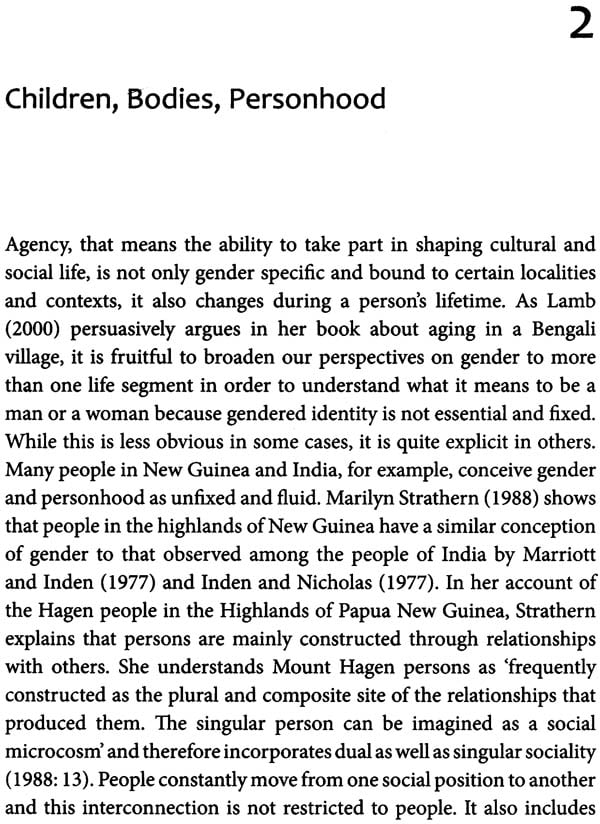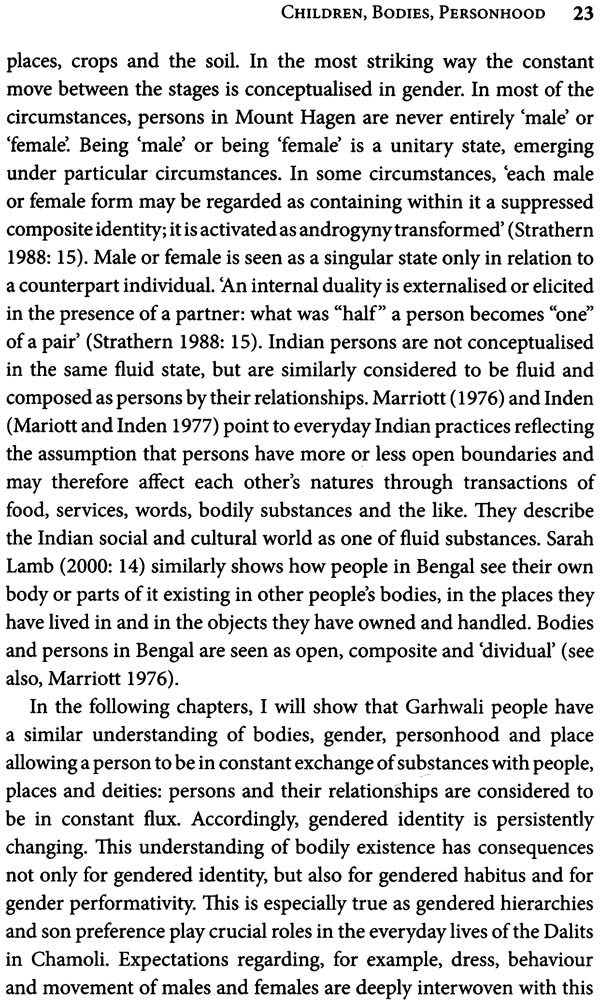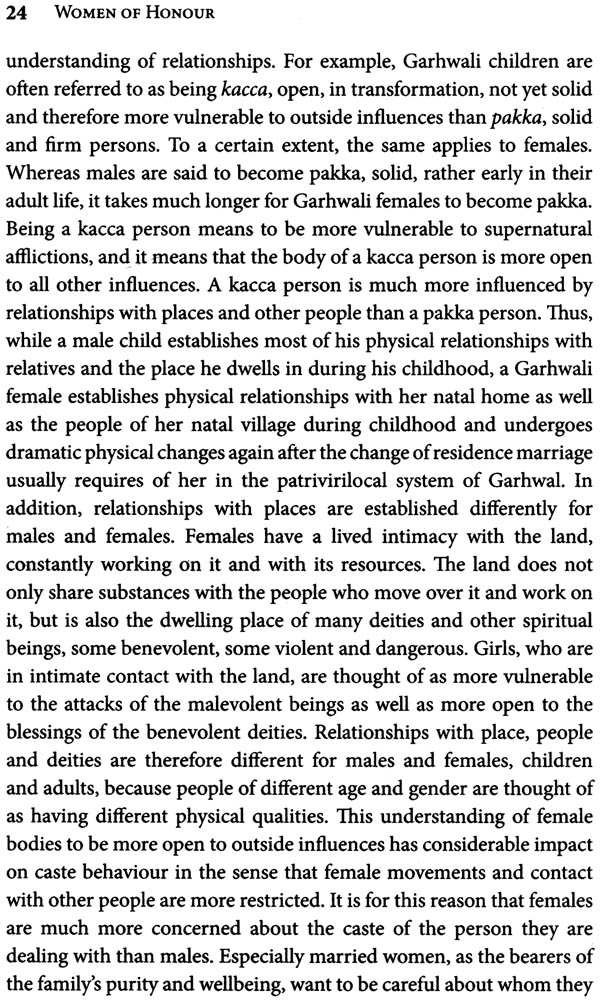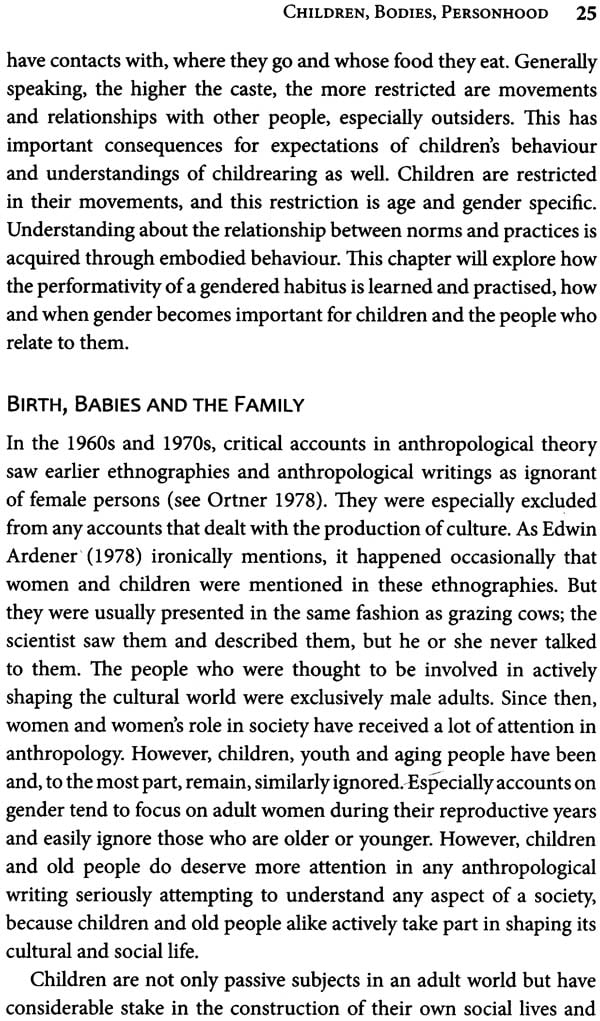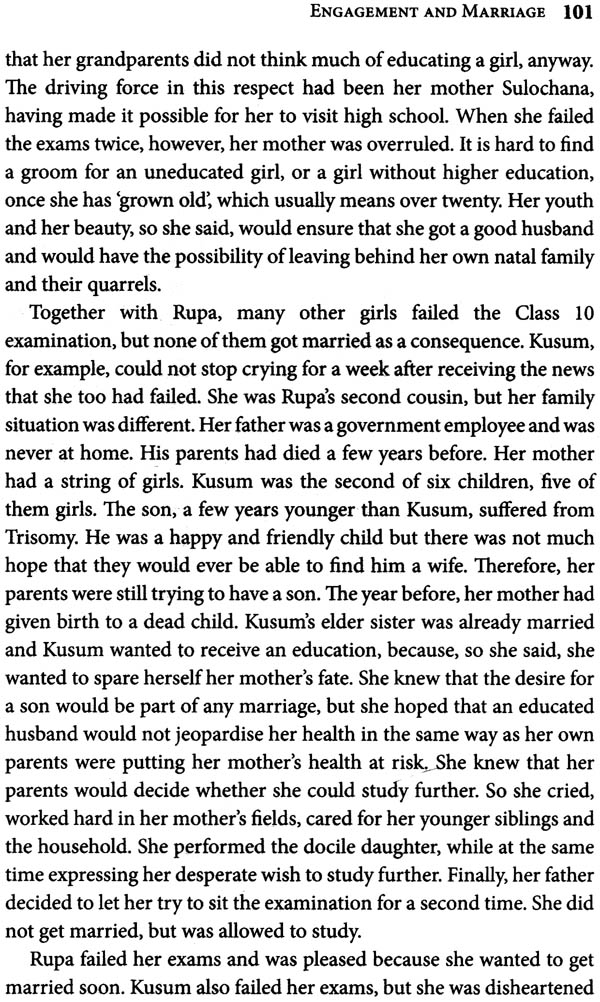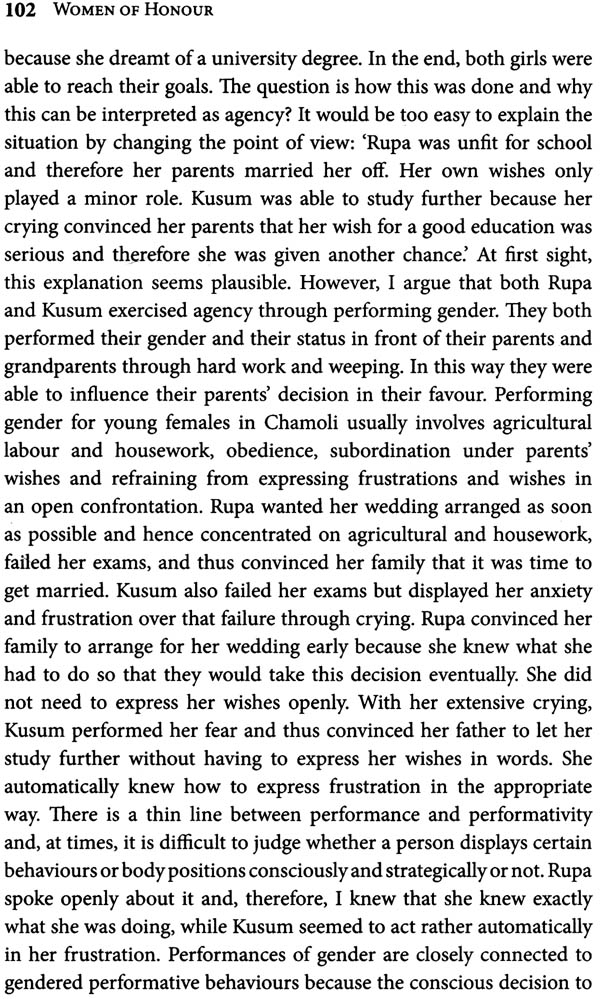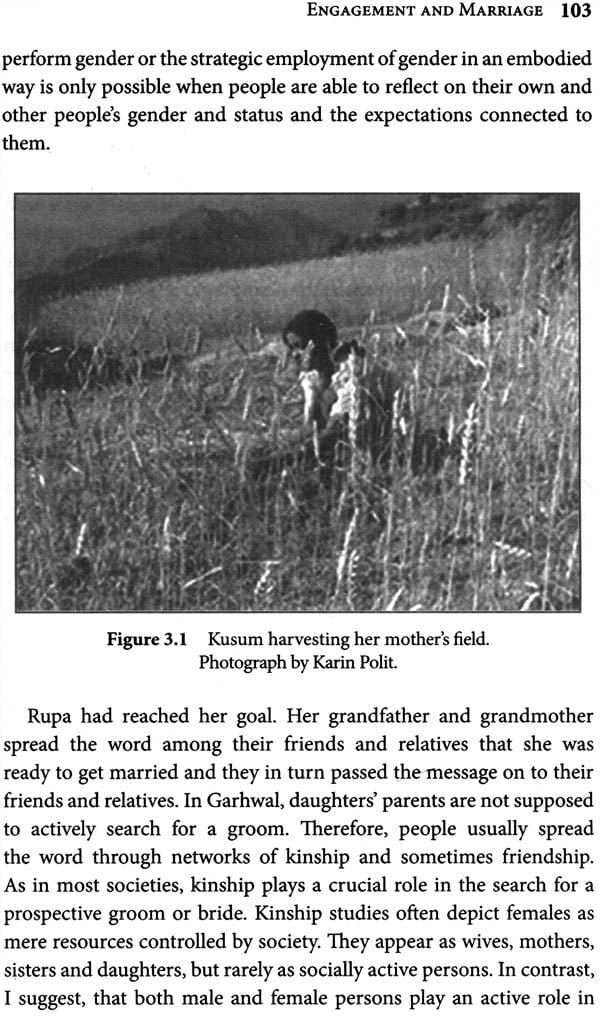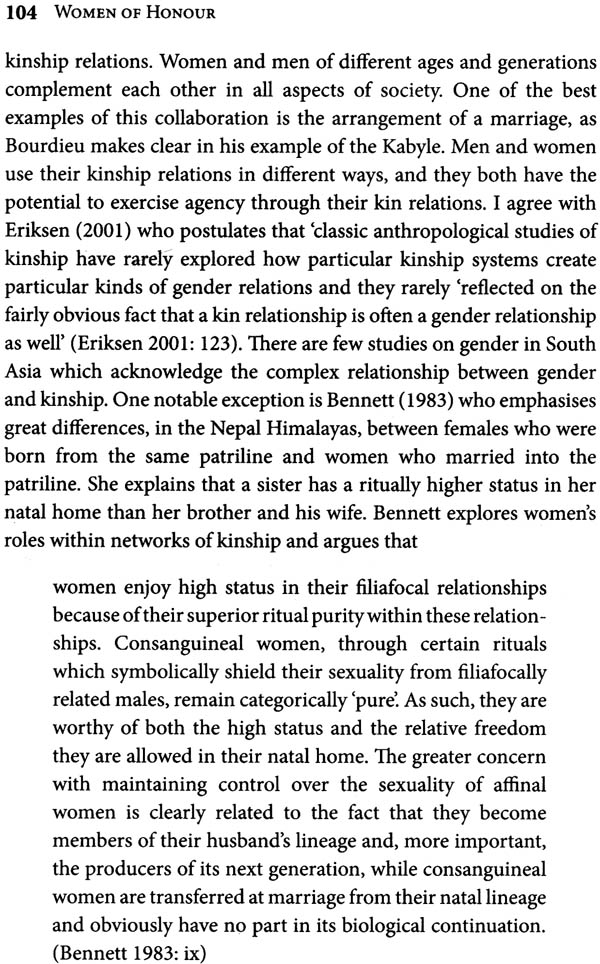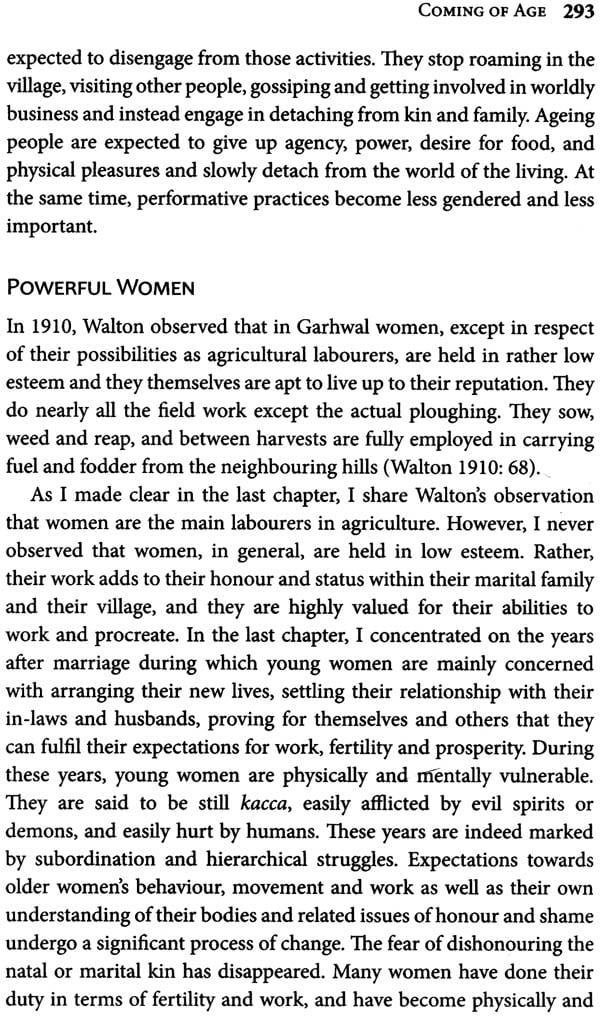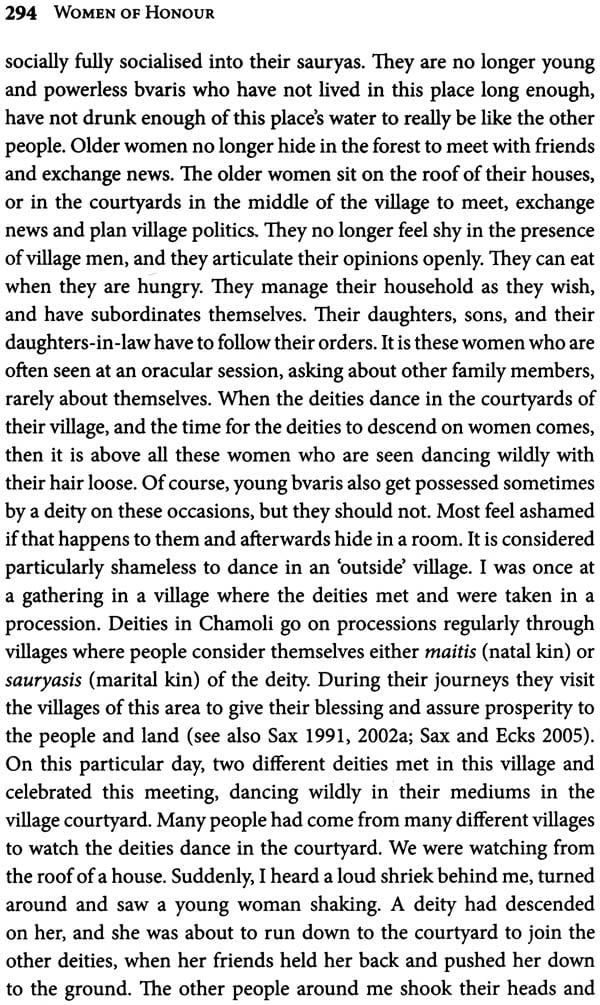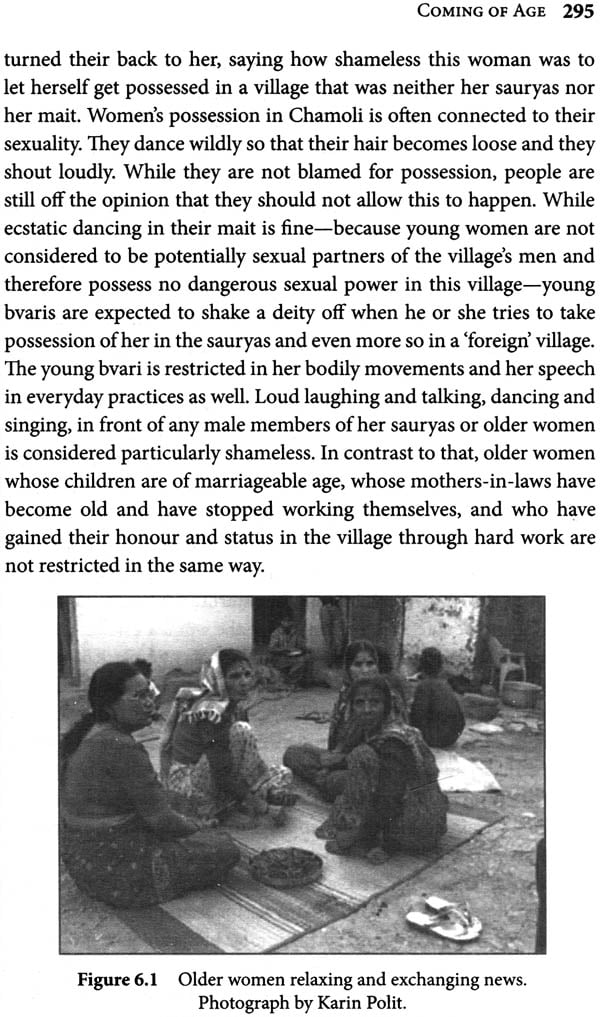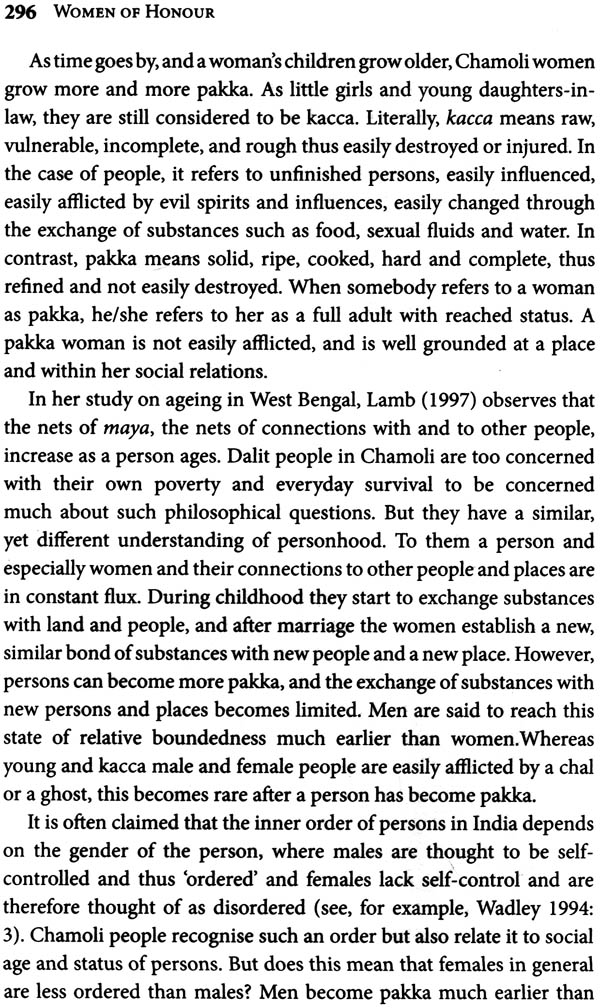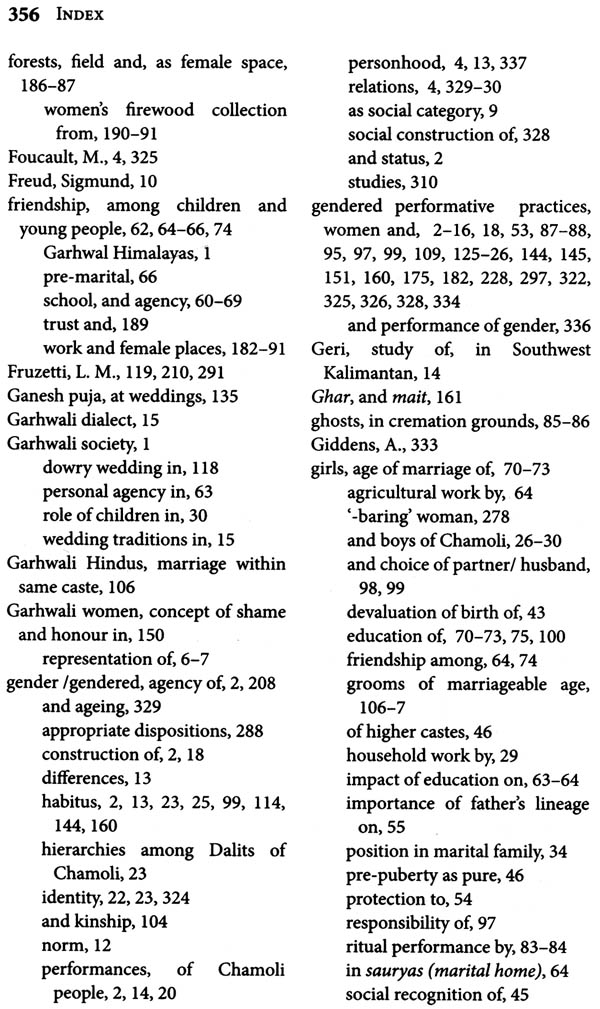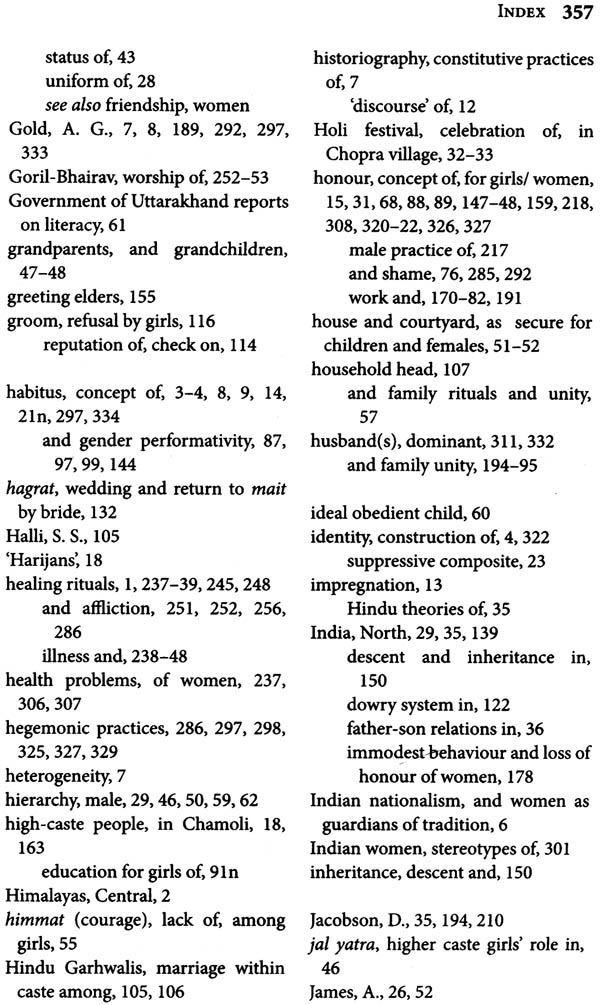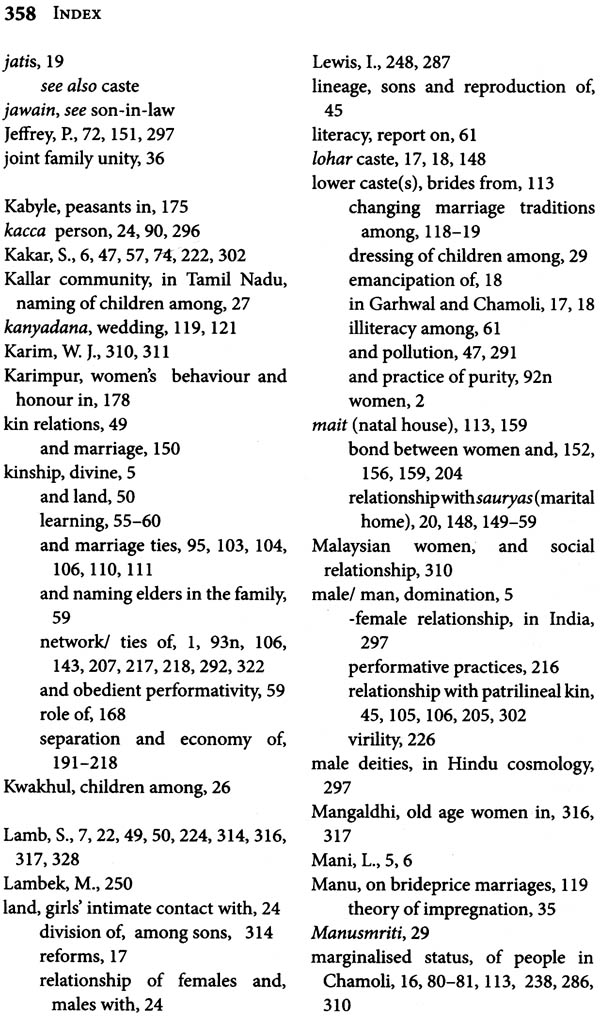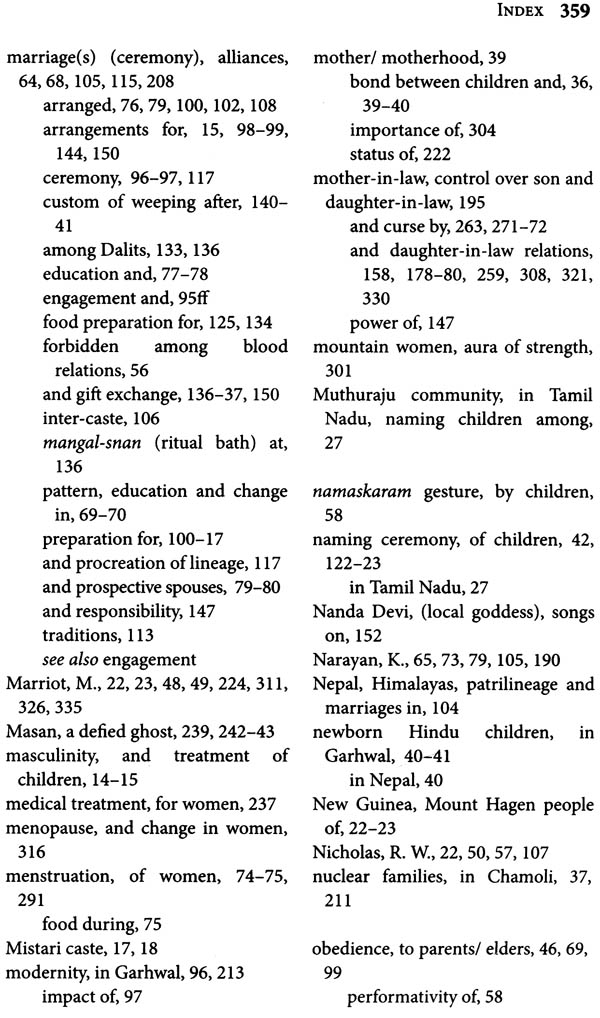
Women of Honour (Gender and Agency Among Dalit Women in the Central Himalayas)
Book Specification
| Item Code: | NAG476 |
| Author: | Karin M. Polit |
| Publisher: | Orient Blackswan Pvt. Ltd. |
| Language: | English |
| Edition: | 2012 |
| ISBN: | 9788125042679 |
| Pages: | 380 |
| Cover: | Hardcover |
| Other Details | 8.5 inch X 5.5 inch |
| Weight | 570 gm |
Book Description
About the Book
Women of Honour is an ethnography describing how local understandings of gender, morality and honour are deeply embedded in practices of everyday life among the Dalit people of Chamoli, Uttarakhand. Karin Polit's first theoretical concern is to explain, starting with childhood, the gendered habitus that shapes relationships in the villages of this high-altitude district in the Central Himalayas. Through thick descriptions of people's movements, conversations, friendships, dress, work and daily interactions, the author shows that gender identity is a process. She points to the fluidity of personhood over a lifetime.
The second theoretical concern is to question the assumptions that Indian females are mute and powerless, and that their agency is restricted to resistance. The author argues that the specific local discourses and practices of Chamoli construct persons in such a way that they do not understand themselves as independent agents. Women's (and men's) ability to shape their lives depends on their being part of an agentive unity. These networks of agency, which include people as well as divine agents, are described as the basis for an honourable life.
This book would be of interest not only to anthropologists and feminists-Dalit feminists, in particular-but also to sociologists and cultural critics.
About the Author
Karin M. Polit is lecturer both at the South Asia Institute and the Institute for Ethnology, University of Heidelberg, Germany.
Introduction
I never felt more defined and restricted by my sex and gender as I did during the first months of fieldwork in the Garhwal Himalayas. I did not have much choice as to how I was defined by the local people. I also did not have much freedom in the choice of my clothes, my diet, or my behaviour. It was for the first time that I visited India and never before had I known a stronger sense of my femaleness and its social consequences. As a female of child-bearing age I had to accept certain restrictions in terms of access to people and places, and freedom of movement and speech. As a foreign researcher, however, I was allowed to cross certain social boundaries which local women rarely or never crossed. I travelled alone when and where I wanted, rode a motorcycle, and also went to healing rituals which were considered dangerous for local women. It was therefore not only my femaleness that defined me as a person in Garhwal, but also my social role as a foreign researcher with considerably more freedom in my own life than local women and also without the protection and the advantages that come with the interlaced networks of kinship, so important in Garhwali society. In the course of seven years of research, however, I changed. As my knowledge about Garhwali society increased, my networks of human relationships tightened. This experience has helped me tremendously to understand how gender is constructed in Garhwal. Still, my own cultural background and understanding of myself are deeply shaped by the experiences of my childhood and adolescence, and while I am able to somehow copy a Garhwali woman's habitus, I will never be able to fully embody it.
In this work I seek to understand how gender is constructed, how gender and agency are interrelated, and how a gendered habitus is developed. I endeavour to explain practices which constitute a gendered habitus, and try to shed some light on female agency in terms of performances of gender amongst low-caste women in Garhwal. Based on my research in the villages of Chamoli, a high altitude district in the Central Himalayas of North India, I examine women's songs, ordinary conversations, my ethnographic observations, and especially the stories women told me about themselves, in order to understand what shapes their lives and how female agency-that is, their ability to shape their lives-is constituted through habitus, gender performativity, and performances of gender. I seek to present the people of Chamoli-e-male and female, children and adults-as agents, constantly shaping and reshaping their own lives and those of others. In their lives they are engaged in relationships with each other and with other non-human agents, such as the many spiritual beings, which play major roles in Chamoli people's daily lives. How people relate to them and to each other highly depends on age, gender and status. At the same time, human agency is never unconstrained. In fact, it always exists in a social field regulating human society. Recognising the mutual influences of persons, places, spirits, and deities in Chamoli, I would like to set out a view of agency and femininity that acknowledges Chamoli women as active agents while not denying the power relations at play.
HABITUS, PERFORMATIVITY AND GENDER
My ethnographic analysis is informed by a number of theoretical interests. In presenting my ethnographic data by means of a combination of a Bourdieuian and Butlerian reading, I will not only identify gendered performative practices in Chamoli, but will also ask whether men and women have room for strategic action and agency. I will examine whether gender performativity and gendered practices-what I will call gendered performative practices-lead to performances of gender which combine strategic agency with practical mastery. I will use Bourdieus ideas on how societies work to find a theoretical access to gendered practices which leaves room for female agency. It is at this point that I find the ideas of Iudith Butler on gender as a process, and as a becoming, very useful (see Butler 1990, 1993, 1997a). A combination of Bourdieu's theory of practice (1977) with Butler's ideas of gender performativity (see Butler 1990, 1993, 1997a) enables me to see gender as a lived social relation (see also, McNay 2004) based on relational practices. I wish to position my arguments about gender in the Central Himalayas to comment on current understandings of agency, power, and resistance within anthropology. I am especially interested in gender studies insofar as they have been concerned with the de construction of the concept of 'woman' and have postulated the idea of female agency as resistance.
I wish to investigate whether Chamoli women can be said to engage in what James Scott (1985) calls 'everyday forms of resistance' or to be involved in 'women's moral discourse and everyday resistance' as identified by Raheja and Gold (1994: O. I ask whether Chamoli women can be understood as muted and subordinate to hegemonic structures more than Chamoli men are. In this way, I wish to understand how female identity is constructed in Chamoli, and whether an important part of female agency centres around individual females or groups of females resisting hegemonic structures. I am also interested in those practices of Chamoli society that perpetuate gender differences and hegemonic powers.
To examine personhood and agency, I draw heavily on Bourdieu's understanding of habitus and practical mastery and on Judith Butler's concept of gender performativity. Bourdieu's concept of habitus is useful because it replaces the notion of a transcendent rule with the idea of embodied practices which govern the social world, ideas, and identities out of which apparent 'rules' for societies develop. According to Bourdieu, embodied dispositions that are acquired through practices in social fields constitute a persons habitus and lead to the practical mastery of social persons which in turn enable them to act in socially acceptable and strategic ways. However, Bourdieus concept lacks a serious analysis of gendered identities and practices, and therefore I propose to complement it with Judith Butler's notions of the gendering of the subject as an effect of discourse. Like Bourdieu, Butler is not interested in individual experience, but in the analysis of processes constructing persons and their positions as subjects in the social world. To Butler, identity is constructed through language and discourse. Consequently, she argues, gender is a process, not an essence, and it is constructed through practices of gender performativity. To Butler, gender performativity constructs social subjects. Processes of gender performativity, according to Butler, enable personal subjectivity. In this line of argument consciousness and subjectivity are products of gender performativity. Hence, all social beings embody dispositions which are part of the discourses played out through gender performativity. And this is why gendered dispositions and the way we understand bodies are usually naturalised. Both Butler and Bourdieu assume that most of these processes are unintentional to the extent that they constitute subjects. I wish to combine these aspects of Butler's theory with Bourdieu's idea of the habitus and social fields to investigate how gender is constructed in Chamoli and how the embodied practices in Chamoli produce gendered persons. While doing so, I will ask how gender, gender performativity and embodied practices are connected to agency and power, invoking Poucaults understanding of power as the inherent glue of human relationships.
One of the most important insights of Foucault's work is that power cannot be understood as something that is in the hands of one group which rules over all others. Rather, he understands power as the organising principle of human relationships that is constantly negotiated and recreated. In this understanding, power defines human bodies as much as it is generated by them (Foucault 1976).
When dealing with gender relations, this means that we cannot simply assume that males generally have more agency than females. Instead, we need to consider relationships within families and across generational boundaries. Especially in rural India agency is rarely exercised on an individual level. It is rather shared by a number of people within a family unit. In his discussion of orientalist discourse on India in general, Inden claims that 'the agency of Indians, the capacity of Indians to make their world, has been displaced ... on to other agents, ... on to one or more "essences" (Inden 1992: 5). The essences imagined are, for example, caste, the Indian mind, or divine kingship. I argue that the agency of Hindu females in India has similarly been displaced by scholars concerned with personhood, psychology, and feminist issues. Essences, such as 'femaleness' and 'caste' were-and have been-considered to restrict the agency of females in South Asia. These theoretical frameworks, however, tend to ignore that every member of any given society is restricted in his or her agency by certain power relations. In focusing on female agency, I therefore want to question stereotypes of Indian women as passive patients of male domination and investigate how and under which circumstances they exercise agency in their own worlds. I follow a definition of agency postulated by Sax (2002b: 2) for whom it is 'more than just "free will" or "resistance", It is 'the ability to transform the world' on whatever scale this might occur. This implies that a woman can be said to exercise agency if she is able to take an active part in shaping her life and that of her family. It also implies that agency does not necessarily have to be restricted to individuals but can also be exercised as part of a larger unit. The transformation of the world, as Merz (2002: 2-4) points out, happens not only in relation to other persons, but also in a context of mutual understanding with others. Or, as Inden puts it, 'all agents are relatively complex and shifting. They make and remake one another through a dialectic process in changing situations' (Inden 1992: 2). This understanding of agency is based on the assumption that all human beings are active participants in their world, constantly creating and recreating themselves and their social fields. In writing about them, it is important to report difficult situations but ignoring people's agency and assuming them muted does not do justice to lived realities.
Contents
| List of Figures | ix | |
| Acknowledgements | xi | |
| Note on Transliteration | xiii | |
| Glossary | xiv | |
| 1 | Introduction | 1 |
| 2 | Children, Bodies, Personhood | 22 |
| 3 | Engagement and Marriage | 95 |
| 4 | Taking on Responsibility | 147 |
| 5 | Wombs, Spirits and Male Offspring` | 222 |
| 6 | Coming of Age | 291 |
| 7 | Reflections on Agency and Performance | 324 |
| References | 338 | |
| Index | 351 |
